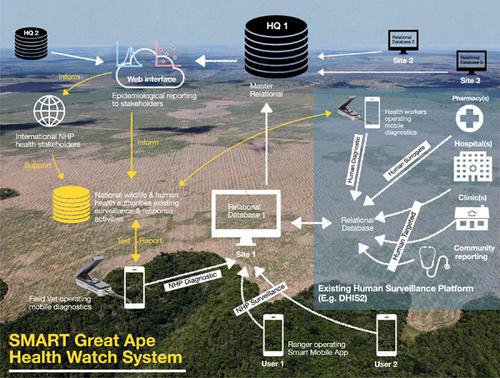当前位置:
X-MOL 学术
›
Am. J. Primatol.
›
论文详情
Our official English website, www.x-mol.net, welcomes your feedback! (Note: you will need to create a separate account there.)
Great ape health watch: Enhancing surveillance for emerging infectious diseases in great apes
American Journal of Primatology ( IF 2.4 ) Pub Date : 2022-04-07 , DOI: 10.1002/ajp.23379 Dawn M Zimmerman 1, 2, 3 , Stephanie L Mitchell 1 , Tiffany M Wolf 4 , Jessica R Deere 4 , Jean Bosco Noheri 5 , Emi Takahashi 6 , Michael R Cranfield 3, 5 , Dominic A Travis 3, 4 , James M Hassell 1, 2
American Journal of Primatology ( IF 2.4 ) Pub Date : 2022-04-07 , DOI: 10.1002/ajp.23379 Dawn M Zimmerman 1, 2, 3 , Stephanie L Mitchell 1 , Tiffany M Wolf 4 , Jessica R Deere 4 , Jean Bosco Noheri 5 , Emi Takahashi 6 , Michael R Cranfield 3, 5 , Dominic A Travis 3, 4 , James M Hassell 1, 2
Affiliation

|
Infectious diseases have the potential to extirpate populations of great apes. As the interface between humans and great apes expands, zoonoses pose an increasingly severe threat to already endangered great ape populations. Despite recognition of the threat posed by human pathogens to great apes, health monitoring is only conducted for a small fraction of the world's wild great apes (and mostly those that are habituated) meaning that outbreaks of disease often go unrecognized and therefore unmitigated. This lack of surveillance (even in sites where capacity to conduct surveillance is present) is the most significant limiting factor in our ability to quickly detect and respond to emerging infectious diseases in great apes when they first appear. Accordingly, we must create a surveillance system that links disease outbreaks in humans and great apes in time and space, and enables veterinarians, clinicians, conservation managers, national decision makers, and the global health community to respond quickly to these events. Here, we review existing great ape health surveillance programs in African range habitats to identify successes, gaps, and challenges. We use these findings to argue that standardization of surveillance across sites and geographic scales, that monitors primate health in real-time and generates early warnings of disease outbreaks, is an efficient, low-cost step to conserve great ape populations. Such a surveillance program, which we call “Great Ape Health Watch” would lead to long-term improvements in outbreak preparedness, prevention, detection, and response, while generating valuable data for epidemiological research and sustainable conservation planning. Standardized monitoring of great apes would also make it easier to integrate with human surveillance activities. This approach would empower local stakeholders to link wildlife and human health, allowing for near real-time, bidirectional surveillance at the great ape-human interface.
中文翻译:

类人猿健康观察:加强对类人猿新发传染病的监测
传染病有可能使类人猿种群灭绝。随着人类与类人猿接触面的扩大,人畜共患病对已经濒临灭绝的类人猿种群构成了越来越严重的威胁。尽管人类病原体对类人猿构成威胁,但健康监测只针对世界上一小部分野生类人猿(主要是那些已经习惯的类人猿)进行,这意味着疾病的爆发往往未被发现,因此无法缓解。这种缺乏监测(即使在有监测能力的地方)是我们在类人猿首次出现时快速检测和应对新发传染病的能力的最重要限制因素。因此,我们必须建立一个监测系统,将人类和类人猿的疾病暴发在时间和空间上联系起来,使兽医、临床医生、保护管理者、国家决策者和全球卫生界能够迅速应对这些事件。在这里,我们回顾了非洲范围栖息地现有的类人猿健康监测计划,以确定成功、差距和挑战。我们利用这些发现来论证跨地点和地理尺度的监测标准化,实时监测灵长类动物的健康状况并产生疾病爆发的早期预警,是保护类人猿种群的有效、低成本的步骤。这种我们称之为“大猿健康观察”的监测计划将长期改善疫情的准备、预防、检测和响应,同时为流行病学研究和可持续保护规划生成有价值的数据。对类人猿的标准化监测也将更容易与人类监测活动相结合。这种方法将使当地利益相关者能够将野生动物与人类健康联系起来,从而在类人猿-人类界面上进行近乎实时的双向监控。
更新日期:2022-04-07
中文翻译:

类人猿健康观察:加强对类人猿新发传染病的监测
传染病有可能使类人猿种群灭绝。随着人类与类人猿接触面的扩大,人畜共患病对已经濒临灭绝的类人猿种群构成了越来越严重的威胁。尽管人类病原体对类人猿构成威胁,但健康监测只针对世界上一小部分野生类人猿(主要是那些已经习惯的类人猿)进行,这意味着疾病的爆发往往未被发现,因此无法缓解。这种缺乏监测(即使在有监测能力的地方)是我们在类人猿首次出现时快速检测和应对新发传染病的能力的最重要限制因素。因此,我们必须建立一个监测系统,将人类和类人猿的疾病暴发在时间和空间上联系起来,使兽医、临床医生、保护管理者、国家决策者和全球卫生界能够迅速应对这些事件。在这里,我们回顾了非洲范围栖息地现有的类人猿健康监测计划,以确定成功、差距和挑战。我们利用这些发现来论证跨地点和地理尺度的监测标准化,实时监测灵长类动物的健康状况并产生疾病爆发的早期预警,是保护类人猿种群的有效、低成本的步骤。这种我们称之为“大猿健康观察”的监测计划将长期改善疫情的准备、预防、检测和响应,同时为流行病学研究和可持续保护规划生成有价值的数据。对类人猿的标准化监测也将更容易与人类监测活动相结合。这种方法将使当地利益相关者能够将野生动物与人类健康联系起来,从而在类人猿-人类界面上进行近乎实时的双向监控。


























 京公网安备 11010802027423号
京公网安备 11010802027423号